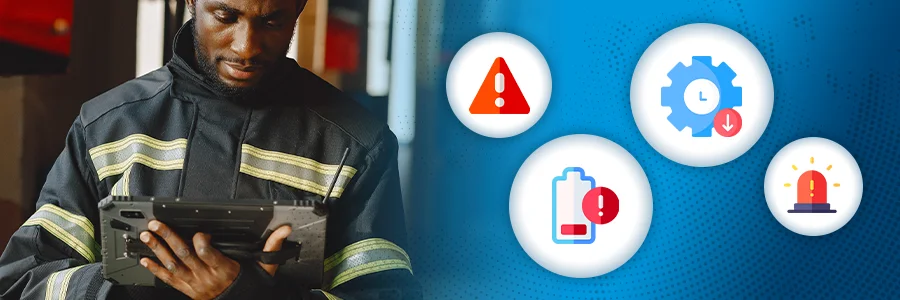
As uncovered in the SOTI emergency services report Digitizing the Frontline: Transformative Technologies in Critical Care, technology problems exacerbate already stressful situations.
Emergency workers can’t communicate with colleagues. It delays access to information, thus delaying critical decision making. It blocks the ability to document and report on changing conditions.
Technology is available for emergency services, but issues obstruct its adoption and effectiveness. Here are four key takeaways from Digitizing the Frontline.

WANT THE FULL PICTURE?
Download Digitizing the Frontline: Transformative Technologies in Critical Care
1. First Responders Experience Device Issues
First responders should trust that technology will just work. But at least once a week, they deal with frustrating, time-consuming issues:
- 68% have app problems
- 63% experience device crashes
- 60% encounter problems with digital forms
Oftentimes, workers look at their devices and ask, “What now?” when issues occur. The public puts its trust in first responders for help. First responders require the same depth of trust in their technology.
2. Batteries Are a Problem
Dealing with an emergency can take hours. First responders need to know their devices can last the entire time.
According to the emergency services report, first responders often worry about their devices not having enough battery power. The data suggests their worries are not unfounded:
- 29% say battery issues impact their devices two or three times per week
- 26% begin their shifts with an uncharged device at least once per week
Solving the issue requires charging the battery, which delays the start of work. It can also involve swapping out a dead battery for a charged one. That is, if a spare battery is available. If not, one needs to be brought to the worker, also delaying the start of work.

PREDICT BATTERY LIFECYCLES
3. Downtime Adds Stress to Already Stressful Situations
First responders are under tremendous stress. They must be able to calmly assess and control often chaotic situations. When technology hinders them from doing their jobs, it increases already high levels of stress.
Globally, 74% of first responders feel adequately trained in the technology they use. Yet they’re not equipped – nor have time – to deal with downtime. And that’s when stress goes up:
- Overall, 38% of first responders experience more stress when there are device issues.
- Specifically, when apps aren’t working, the number swells to 43%.
Emergency service workers face intense pressure and unexpected conditions that put their skills and emotions to the test. They simply cannot be interrupted for something like slow uploads which impact 73% of first responders.
4. Device Issues Delay Critical Care
Minutes waiting for device issue resolution are minutes not spent helping or attending to victims. Even a one-minute delay has consequences. Of course, device issues are rarely just one minute.
As noted in the report, here is the average length of device downtime for selected frontline workers:
- Ambulance service workers: 18 minutes
- Search and rescue team members: 24 minutes
Globally, 31% stated it takes 10 minutes to resolve a device issue. But for 20%, it’s 30 minutes or more. That’s 30 minutes of no communication with colleagues. Thirty minutes of no access to critical data. Thirty minutes of stalled decision making.
Worst of all: 30 minutes of being unable to assist those in need.
Want to Know More? Download Digitizing the Frontline Now
These stats are only part of the data and insights found in Digitizing the Frontline: Transformative Technologies in Critical Care. You’ll also learn:
- Where and how poor Wi-Fi limits first responders
- Risks of relying on pen-and-paper methods
- How to unlock the digital future of emergency services
Reliable technology enables workers to respond and perform with speed and efficiency. This report looks at the true effect of unreliable technology. It’s a must read for anyone responsible for procuring, deploying or using technology for emergency services.



